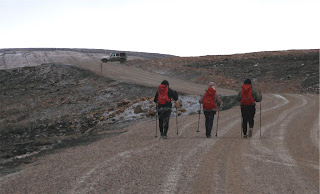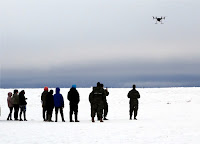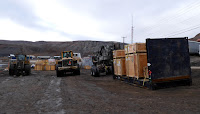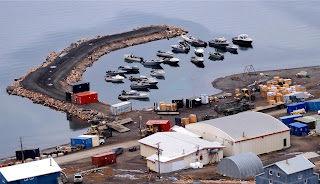Operation Hill Top 21 went ahead with a reduced schedule due to COVID-19 restrictions. The cadets and staff of 3045 Army Cadet Corps normally spend two nights camping over the weekend, learning & reviewing various skills, and completing a 7-kilometre hike. This year the field training exercise (FTX) could only be a one-day event. That still gave us plenty of time to complete the main objective: the 7km hike. It’s a requirement in the cadet program because it prepares cadets for more demanding hikes in their senior years.
The staging area for the FTX has been the Second Bridge on the Road to Nanisivik since 2013. The hikes have been done in one and/or two groups. If you have read my previous posts about the FTX, you know we either hike to the First Bridge or 7km towards Nanisivik. There would only be one hiking group this year. This year the cadets were going to hike 10km. The final destination would be the old Nanisivik Airport. Canadian made Individual Meal Packages (IMPs) and the equipment to cook them would be waiting for them; an added incentive.
The FTX began in the early morning on September 18. Everyone assembled at the Uquutaq Centre at 9:30am for breakfast. The meal was prepared by the same parent who prepared breakfast for the beach cleanup at the beginning of the month. Unfortunately, there was no electricity due to work being done on the power grid, so a generator had to be used to power a microwave for heating the egg McMuffins. We ate in semi-darkness. Natural light shined through tall narrow windows. The cadets cleaned the place up after breakfast and we drove to the Second Bridge in a convoy of two pickup trucks and a jeep.
A white tent had already been set up at the staging area prior to our arrival thanks to Frank and his helpers. The cadets moved the supplies & equipment we brought inside the tent. I fired one slug from my 12-gauge shot gun away from the camp to scare away any lurking aggressive wildlife. Unfortunately, the Canadian Rangers were unavailable to provide polar bear protection, so it had to be me. Technically, we don’t need Rangers if we’re only staying out for a day.
Preparations
for the 10km hike included handing out backpacks & walking sticks, and
dividing various supplies amongst the cadets.
The cadets would carry granola bars, juice boxes, garbage bags, and toilet
paper. I would also carry those supplies
as well as a first aid kit. A cadet
parent would drive ahead in their jeep to make sure the road was clear and
assist us in an emergency.
The hike began at 10:45am.
The cadets followed the road up a hill; our first ascent. I walked behind them. I took several pictures of the campsite when I got to the top. Normally, I would have the cadets walk together, but since we had a parent as a forward lookout, I was okay with the group being stretched out, as long as they remained between the jeep and I. The weather was a little cold.
The hike consisted of walking, more walking, and even more walking. We took a few snack & juice breaks to replenish our strength.
Nanisivik Airport in the distance.
We saw the Nanisivik Airport buildings after 90 minutes of hiking. They were to our right, on top of a plateau, across very rocky terrain. The cadets asked if we could cut across, but I said no, because it would be cheating. I assured them we were getting closer to our goal; one step at a time.
We reached the 7km mark two hours after we began the hike. Frank was waiting for us in his pickup truck to hand out cups of hot chocolate. The cadet parent was also there. Several cadets sat inside the vehicles to warm up. We rested for 10 minutes then continued walking along the road. The terrain here is a little flatter with less ups & downs.
We reached The Terry Fox Pass monument after 45 minutes. The monument consists of a rocky mound, three flag poles, a dedication plaque, and a separate sign pole that shows the direction and distance to several large cities. Frank was there to inform me that the 10km mark wasn’t the Nanisivik Airport. It was actually the T-intersection. I passed this information along to the cadets who were relieved to know the end was closer than they thought.
Frank moved his truck to the T-intersection and waited for the cadets to pile into the back of the truck. I was the last person to get in because I wanted to photograph the moment. I got inside the truck and Frank drove us the rest of the way.
Lunch was held inside an old First Air Cargo Garage. The cadets cooked their IMPs using Coleman stoves. While the meals were being prepared, I was introduced to two Canadian Armed Forces officers who were leading a survey team. They had been sent to survey & photograph the layout of the airport. Their equipment included an expensive drone. With the nearby Nanisivik Naval Facility nearing completion, maybe the federal government and Department of National Defence (DND) are interested in rebuilding the airport? Only time will tell. The IMPs were delicious.
The cadets & I watched the soldiers fly their expensive looking drone above the tarmac, runway, and buildings. Maybe I’ll buy a drone one day. They look cool and they capture amazing footage from a bird’s eye view. I can also enroll in a legitimate drone training program to feel more comfortable operating the machine.
The cadets & I explored the old dilapidated airport buildings. Though the exteriors look stable, the interiors have seen better days. The terminal building looks much worse than before. The walls & ceiling tiles have fallen to the floor, and there are hanging wires & wooden beams. Thankfully, there is no electricity because the generators have been switched off ages ago. If the DND is serious about resurrecting the airport, then they need to move everything out, throw out a lot of stuff, demolish all the buildings, and then build new ones. It’s not worth renovating the old buildings. Even though the mechanics garage looks salvageable, I wouldn’t keep it. Time for a fresh start!
Can't forget the Creepy Hallway.
The cadets cleaned the First Air Cargo Garage and loaded everything – garbage included – into Frank’s pickup truck. We needed to leave no trace behind. Frank drove us back to the campsite. The garbage bags were left in the truck while the backpacks, walking poles, leftover food, and Coleman stoves were brought back inside the tent.
The
cadets enjoyed an hour of free time.
Some played frisbee.
Large pieces of wood had been brought to the campsite for an evening bonfire. The cadets built the bonfire at 5:30pm and had the fire going by 6:15pm. Several cadets helped me move the bonfire food, two cots, foldout table, and roasting sticks to the bonfire site. The bonfire food – hot dogs, marshmallows, & juice boxes - would serve as dinner.
The cadets did an excellent job keeping the fire going and not getting burned. We all dined on hot dogs and marshmallows. A fitting end to an FTX. There’s not much else for me to say. I guess I can add the bonfire burned brightly.
The
fire was extinguished, the tent was taken down, and everything was loaded into vehicles. The cadets did one last garbage sweep of the
campsite. The convoy left the Second
Bridge.
We stopped at Frank’s shop to unload and put away all the cadet supplies. I held a quick debriefing, congratulating the cadets for completing the 10km hike. The shop was locked up and everyone was driven home. The FTX was officially over.
Before I go, I would like you all to know that I will be taking a brief break from my blogging duties for the next 3 weeks. A great opportunity came up that I can’t pass and it’ll be taking place outside the territory. I’ll explain more when I come back in October.

























































